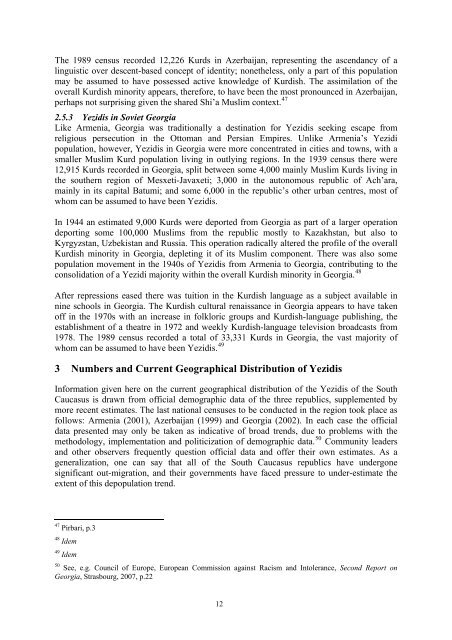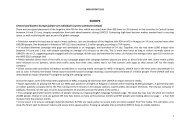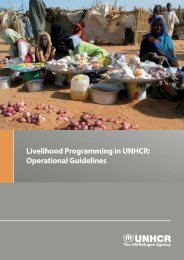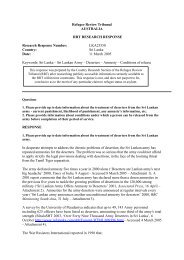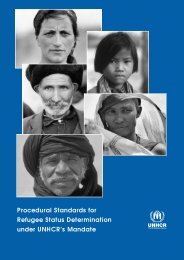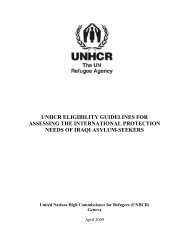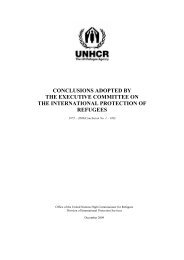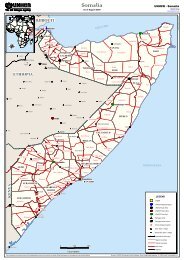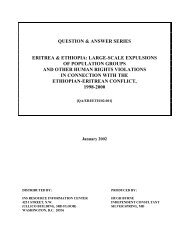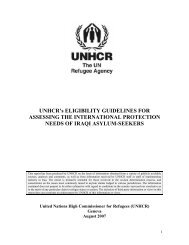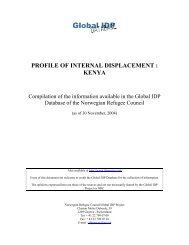The Human Rights situation of the Yezidi minority - UNHCR
The Human Rights situation of the Yezidi minority - UNHCR
The Human Rights situation of the Yezidi minority - UNHCR
You also want an ePaper? Increase the reach of your titles
YUMPU automatically turns print PDFs into web optimized ePapers that Google loves.
<strong>The</strong> 1989 census recorded 12,226 Kurds in Azerbaijan, representing <strong>the</strong> ascendancy <strong>of</strong> a<br />
linguistic over descent-based concept <strong>of</strong> identity; none<strong>the</strong>less, only a part <strong>of</strong> this population<br />
may be assumed to have possessed active knowledge <strong>of</strong> Kurdish. <strong>The</strong> assimilation <strong>of</strong> <strong>the</strong><br />
overall Kurdish <strong>minority</strong> appears, <strong>the</strong>refore, to have been <strong>the</strong> most pronounced in Azerbaijan,<br />
perhaps not surprising given <strong>the</strong> shared Shi’a Muslim context. 47<br />
2.5.3 <strong>Yezidi</strong>s in Soviet Georgia<br />
Like Armenia, Georgia was traditionally a destination for <strong>Yezidi</strong>s seeking escape from<br />
religious persecution in <strong>the</strong> Ottoman and Persian Empires. Unlike Armenia’s <strong>Yezidi</strong><br />
population, however, <strong>Yezidi</strong>s in Georgia were more concentrated in cities and towns, with a<br />
smaller Muslim Kurd population living in outlying regions. In <strong>the</strong> 1939 census <strong>the</strong>re were<br />
12,915 Kurds recorded in Georgia, split between some 4,000 mainly Muslim Kurds living in<br />
<strong>the</strong> sou<strong>the</strong>rn region <strong>of</strong> Mesxeti-Javaxeti; 3,000 in <strong>the</strong> autonomous republic <strong>of</strong> Ach’ara,<br />
mainly in its capital Batumi; and some 6,000 in <strong>the</strong> republic’s o<strong>the</strong>r urban centres, most <strong>of</strong><br />
whom can be assumed to have been <strong>Yezidi</strong>s.<br />
In 1944 an estimated 9,000 Kurds were deported from Georgia as part <strong>of</strong> a larger operation<br />
deporting some 100,000 Muslims from <strong>the</strong> republic mostly to Kazakhstan, but also to<br />
Kyrgyzstan, Uzbekistan and Russia. This operation radically altered <strong>the</strong> pr<strong>of</strong>ile <strong>of</strong> <strong>the</strong> overall<br />
Kurdish <strong>minority</strong> in Georgia, depleting it <strong>of</strong> its Muslim component. <strong>The</strong>re was also some<br />
population movement in <strong>the</strong> 1940s <strong>of</strong> <strong>Yezidi</strong>s from Armenia to Georgia, contributing to <strong>the</strong><br />
consolidation <strong>of</strong> a <strong>Yezidi</strong> majority within <strong>the</strong> overall Kurdish <strong>minority</strong> in Georgia. 48<br />
After repressions eased <strong>the</strong>re was tuition in <strong>the</strong> Kurdish language as a subject available in<br />
nine schools in Georgia. <strong>The</strong> Kurdish cultural renaissance in Georgia appears to have taken<br />
<strong>of</strong>f in <strong>the</strong> 1970s with an increase in folkloric groups and Kurdish-language publishing, <strong>the</strong><br />
establishment <strong>of</strong> a <strong>the</strong>atre in 1972 and weekly Kurdish-language television broadcasts from<br />
1978. <strong>The</strong> 1989 census recorded a total <strong>of</strong> 33,331 Kurds in Georgia, <strong>the</strong> vast majority <strong>of</strong><br />
whom can be assumed to have been <strong>Yezidi</strong>s. 49<br />
3 Numbers and Current Geographical Distribution <strong>of</strong> <strong>Yezidi</strong>s<br />
Information given here on <strong>the</strong> current geographical distribution <strong>of</strong> <strong>the</strong> <strong>Yezidi</strong>s <strong>of</strong> <strong>the</strong> South<br />
Caucasus is drawn from <strong>of</strong>ficial demographic data <strong>of</strong> <strong>the</strong> three republics, supplemented by<br />
more recent estimates. <strong>The</strong> last national censuses to be conducted in <strong>the</strong> region took place as<br />
follows: Armenia (2001), Azerbaijan (1999) and Georgia (2002). In each case <strong>the</strong> <strong>of</strong>ficial<br />
data presented may only be taken as indicative <strong>of</strong> broad trends, due to problems with <strong>the</strong><br />
methodology, implementation and politicization <strong>of</strong> demographic data. 50 Community leaders<br />
and o<strong>the</strong>r observers frequently question <strong>of</strong>ficial data and <strong>of</strong>fer <strong>the</strong>ir own estimates. As a<br />
generalization, one can say that all <strong>of</strong> <strong>the</strong> South Caucasus republics have undergone<br />
significant out-migration, and <strong>the</strong>ir governments have faced pressure to under-estimate <strong>the</strong><br />
extent <strong>of</strong> this depopulation trend.<br />
47 Pirbari, p.3<br />
48 Idem<br />
49 Idem<br />
50 See, e.g. Council <strong>of</strong> Europe, European Commission against Racism and Intolerance, Second Report on<br />
Georgia, Strasbourg, 2007, p.22<br />
12


